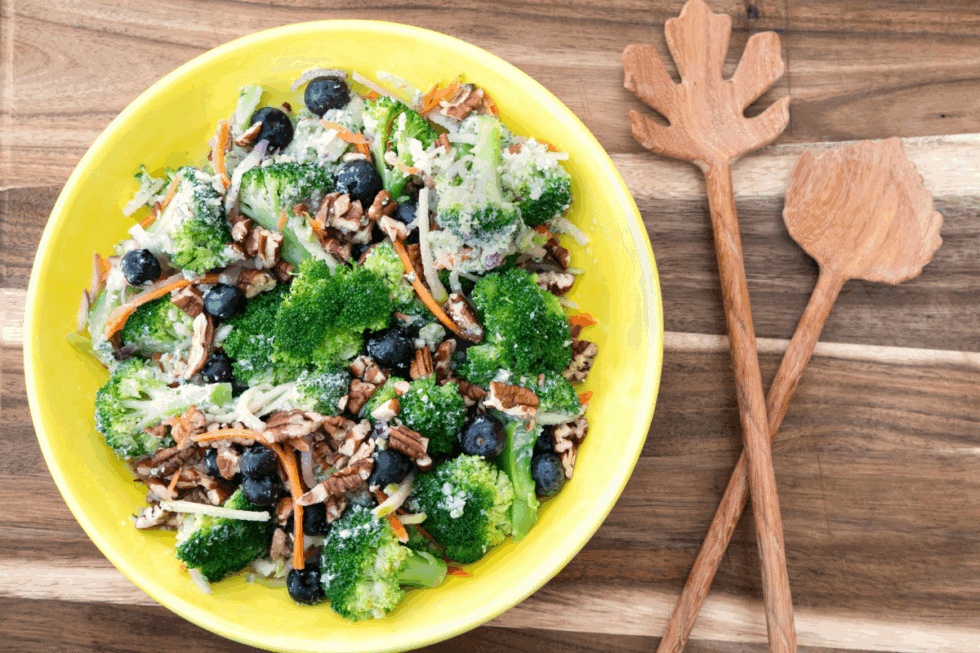
Is Broccoli Low Histamine? Broccoli Side Salad Recipe (also Low Oxalate, Low Lectin)
Is broccoli low histamine? Yes!
You’ll find broccoli along with many other veggies on the low histamine food list.
As a popular side item, you’ll often see broccoli steamed or roasted.
It’s usually simply flavored with a bit of butter, ghee, or olive oil and lightly seasoned with salt or garlic.
In this recipe, we’ve dressed up broccoli and turned it into a flavorful low histamine take on a favorite picnic salad.
Broccoli side salads are usually made with broccoli, mayo, cheese, seeds, dried fruits and more.
Many of these standard toppings are high histamine ingredients, though.
But with just a few delicious swaps, you’ve got a tasty salad the entire family get-together will want seconds of!
This recipe is:
- Low histamine
- Low oxalate
- Low lectin
- Dairy free
- Gluten free
- Vegetarian
Keep reading to get the recipe and learn more about:
- The health benefits of broccoli
- Vitamin C benefits for Mast Cell Activation Syndrome and Histamine Intolerance
- Our recipe swaps
Is Broccoli Low Histamine?
Before you change your diet on your own, please make sure you’re working with a healthcare practitioner who can help you with this. Never limit foods unnecessarily, and always have a licensed medical provider who is supervising your case.
You’ll find broccoli and many other cruciferous veggies on the low histamine foods list.
Cruciferous veggies include:
- Arugula
- Bok Choy
- Broccoli
- Brussels Sprouts
- Cabbage
- Cauliflower
- Collard Greens
- Leafy Green Kale
- Radishes
- Turnips
Cruciferous veggies may aid in:
- Reducing Inflammation — fiber, vitamin C, and antioxidants help reduce inflammation
- Regulating Blood Sugar — fiber helps regulate blood sugar levels which can keep histamine levels from spiking
- Digestive Health — fiber promotes regular bowel movements and aids in production of short-chain fatty acids crucial for gut health
- Hormone Balance — compounds such as indole-3-carbinol (I3C) may help regulate estrogen levels
Broccoli is also a rich source of vitamin C.
Here’s more on why vitamin C is important for those with Mast Cell Activation Syndrome (MCAS) or Histamine Intolerance.
Vitamin C for MCAS and Histamine Intolerance
Did you know that broccoli contains more vitamin C per serving than oranges?
One cup of raw broccoli has about 81 mg of vitamin C. That’s about 90% of the daily recommended value.
Vitamin C can be beneficial for those with Mast Cell Activation Syndrome (MCAS) and Histamine Intolerance.
It’s been shown to help bolster the immune system.
And vitamin C naturally contributes to lowering histamine in your body by being a cofactor for the histamine degrading enzyme, DAO (diamine oxidase).
Cofactors assist in the proper functioning of enzymes.
One reason people may suffer from Histamine Intolerance is low DAO.
That’s why you want to make sure to get the proper nutrients needed to support DAO production.
Lowering histamine levels is also helpful for those with MCAS. When mast cells degranulate, they release histamine.
And histamine can further trigger mast cells.
So, lowering histamine can be helpful for both conditions.
Choosing nutrient rich foods is one way to get essential vitamins and minerals.
But sometimes, you may need extra support in the form of supplements.
When it comes to vitamin C, not all types are right for those with MCAS and Histamine Intolerance.
Some forms of vitamin C may actually be contributing to your symptoms!
Related Article: Low Histamine Vitamin C
If you can’t read the article right away, here are our favorite vitamin C supplements.
Magnesium Ascorbate by Allergy Research Group
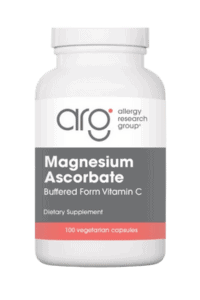
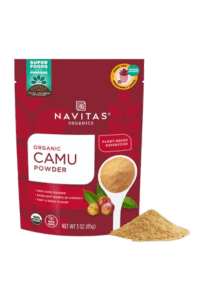
Camu Camu Capsules by Mother Nature
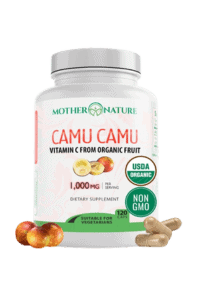
Finally, here’s an overview of the recipe swaps we made to keep this recipe low histamine.
We hope this helps you adapt some of your favorite recipes, too!
Recipe Swaps
There are many variations of broccoli salad.
Some use grated broccoli stems with dried ramen noodles, soy sauce, extra virgin olive oil, sesame seeds, and other grated veggies.
Other recipes make a salad dressing out of mayo and use broccoli florets mixed with sunflower seeds, cheese, bacon, green onions and more.
Broccoli is a good choice for the low histamine diet.
But a lot of those other traditional salad ingredients are high histamine foods.
To lower the histamine content, here’s what we did.
- For our dressing base, we used coconut cream and apple sauce instead of mayo or soy sauce. This makes for a slightly sweeter base.
- You’ll also get sweet notes from the fresh blueberries we used in place of dried fruit like raisins or craisins.
But we have other flavor profile ingredients added to help balance the sweetness.
- We added tart Granny Smith apples.
- And pecans and onions hit the umami profile in place of high lectin sunflower seeds, high histamine peanuts, or aged cheese.
This recipe comes together very easily.
Here’s our top tip for making this recipe even easier.
If you want to make the recipe super easy, you can use raw broccoli.
This means there will be no cook time. Only prep.
We chose to blanch the broccoli because it takes down some of the bitterness of raw broccoli. And it can make it easier to digest.
Interestingly, when select veggies were tested for vitamin retention after blanching, some lost a lot of vitamin C in the process.
However, broccoli retained most of its vitamin C!
Raw or blanched, you can’t go wrong either way.
And you can use a food processor to speed things up, too. We did!
What to Serve with Broccoli Low Histamine Salad
- Low Histamine Chicken Recipe – Low Oxalate, Low Lectin, Low FODMAP, Low Salicylate
- Salmon Recipe – Low Histamine, Low Oxalate, Low Lectin, Low Salicylate, with Low FODMAP option
- Chicken Marinade Skewers – Low Histamine, Medium Oxalate, Low Lectin, Low FODMAP
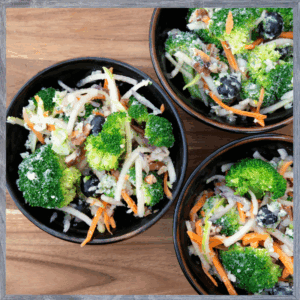
Low Histamine Broccoli Salad
Equipment
- Sharp Knife
- Large Pot
Ingredients
Salad Ingredients
- Filtered Water Ice
- 5 cups Fresh Broccoli Florets
- ½ cup Blueberries
- ½ cup Organic Green Granny Smith Apples cored and greated
- ⅛ cup Red Onion grated
- ½ cup Carrot grated
- ½ cup Pecans chopped
Dressing Ingredients
- ½ cup Let’s Do Organic Coconut Cream
- ½ cup Organic Green Granny Smith Apples cored
- ¼ tsp Redmond Real Salt
- 2 Tbsp Fresh Organic Flat Leaf Parsley generous helping
- 8 Fresh Mint Leaves
Instructions
- Bring a large pot of water to a boil.
- While the water comes to a boil, wash all produce and prepare the salad produce as indicated on the ingredient list (grate or chop).
- Set the broccoli aside for blanching.
- Add all the other salad produce to a large mixing bowl as ready. Set aside.
- Add broccoli florets to the boiling water and blanch for about 1 minute. Color should be bright green.
- Immediately drain the broccoli and place the blanched florets in a bowl of ice to stop the cooking and keep the broccoli crispy.
- Make the dressing by putting all the dressing ingredients (coconut cream, apple, salt, parsley, mint) in a blender. Pulse until mostly smooth. (It’s ok if it still has some texture.)
- Pat the broccoli dry with paper towels or clean dish cloth.
- Add the broccoli to the large bowl with the other salad ingredients. Then toss everything with the dressing and pecans. Add more salt to personal taste.
Notes
Nutrition
This broccoli low histamine salad brings flavor to any potluck! What potluck favorites would you like to see low histamine recipes for?
More Low Histamine Sides
- Asparagus with Garlic and Ginger Sauce – Low Oxalate, Low Lectin
- Waldorf Salad Recipe – Medium Oxalate, Low Lectin, with Low Salicylate option
- Coleslaw Recipe – Low Oxalate, Low Lectin, with Low FODMAP and Low Salicylate options
- Cherry and Arugula Salad – Low Oxalate, Low Lectin
- Sesame Cauliflower – Low Histamine, Low Oxalate, Low Lectin
The website provides approximate nutrition information. Users should calculate the nutritional information with the actual ingredients and quantities they use in their recipes for the most accurate representation.
Some links in this website are affiliate links, which means Mast Cell 360 may make a very small commission if you purchase through the link. It never costs you any more to purchase through the links, and we try to find the best deals we can. We only recommend products that we love and use personally or use in the Mast Cell 360 practice. Any commissions help support the newsletter, website, and ongoing research so Mast Cell 360 can continue to offer you free tips, recipes, and info. Thank you for your support!
References
Ağagündüz, D., et al. (2022). Cruciferous vegetables and their bioactive metabolites: from prevention to novel therapies of colorectal cancer. Evidence-based Complementary and Alternative Medicine, 2022, 1–20. https://doi.org/10.1155/2022/1534083
Auborn, K. J., et al. (2003). Indole-3-Carbinol is a negative regulator of estrogen. Journal of Nutrition, 133(7), 2470S-2475S. https://doi.org/10.1093/jn/133.7.2470s
Bhol, N. K., et al. (2024). The interplay between cytokines, inflammation, and antioxidants: mechanistic insights and therapeutic potentials of various antioxidants and anti-cytokine compounds. Biomedicine & Pharmacotherapy, 178, 117177. https://doi.org/10.1016/j.biopha.2024.117177
Carr, A. C., & Maggini, S. (2017). Vitamin C and immune function. Nutrients, 9(11), 1211. https://doi.org/10.3390/nu9111211
Fiber: the carb that helps you manage diabetes. (2024, May 15). Diabetes. https://www.cdc.gov/diabetes/healthy-eating/fiber-helps-diabetes.html
Fu, J., et al. (2022). Dietary fiber intake and gut microbiota in human health. Microorganisms, 10(12), 2507.
HappyForks. (n.d.). Recipe analyzer. https://happyforks.com/analyzer/result
Hrubisko, M., et al. (2021). Histamine intolerance-The more we know the less we know. A review. Nutrients, 13(7), 2228. https://doi.org/10.3390/nu13072228
Jochum C. (2024). Histamine intolerance: Symptoms, diagnosis, and beyond. Nutrients, 16(8), 1219. https://doi.org/10.3390/nu16081219
Lee, S., et al. (2017). Effect of different cooking methods on the content of vitamins and true retention in selected vegetables. Food Science and Biotechnology, 27(2), 333–342. https://doi.org/10.1007/s10068-017-0281-1
Maintz, L., & Novak, N. (2007). Histamine and histamine intolerance. American Journal of Clinical Nutrition, 85(5), 1185–1196. https://doi.org/10.1093/ajcn/85.5.1185
Schnedl, W. J., & Enko, D. (2021). Histamine intolerance originates in the gut. Nutrients, 13(4), 1262. https://doi.org/10.3390/nu13041262
Shivakoti, R., et al. (2022). Intake and sources of dietary fiber, inflammation, and cardiovascular disease in older US adults. JAMA Network Open, 5(3), e225012. https://doi.org/10.1001/jamanetworkopen.2022.5012
Syed, R. U., et al. (2023). Broccoli: A multi-faceted vegetable for health: An in-depth review of its nutritional attributes, antimicrobial abilities, and anti-inflammatory properties. Antibiotics (Basel, Switzerland), 12(7), 1157. https://doi.org/10.3390/antibiotics12071157


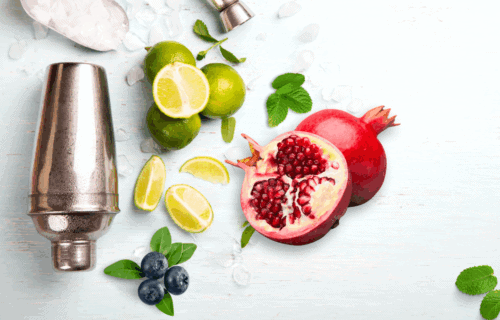
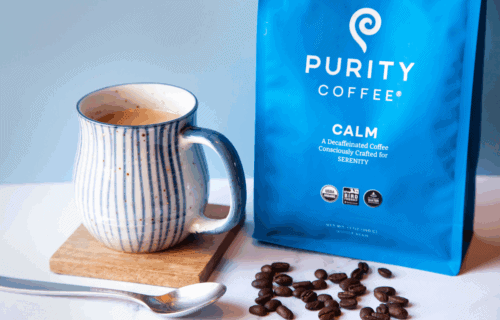
I like this combination. I had no fresh parsley so I just left it out. The fresh mint adds a pleasant counter to the red onion. I think some freshly stir-fried chicken would add ancomplementary taste, texture and protein for a complete meal.
Hi Kathy,
We are glad that you enjoyed the recipe, and thank you for your additional comments.
Best,
Zack